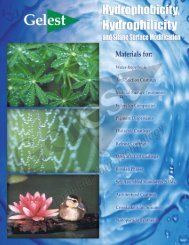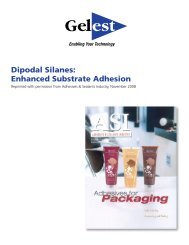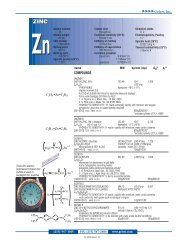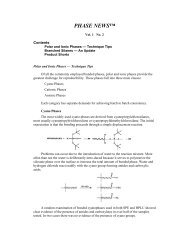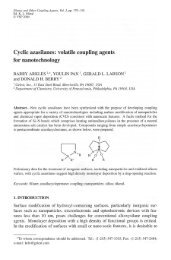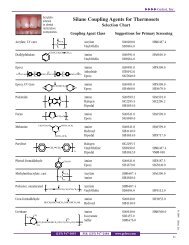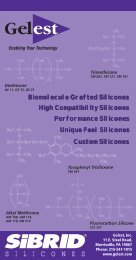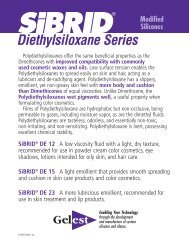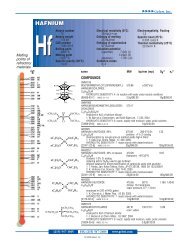Silicone Elastomers by Step-Growth Polymerization of ... - Gelest Inc.
Silicone Elastomers by Step-Growth Polymerization of ... - Gelest Inc.
Silicone Elastomers by Step-Growth Polymerization of ... - Gelest Inc.
Create successful ePaper yourself
Turn your PDF publications into a flip-book with our unique Google optimized e-Paper software.
SILICONE ELASTOMERS BY STEP-GROWTH POLYMERIZATION<br />
OF MONODISPERSE DUAL FUNCTIONAL SILICONES<br />
Jonathan G<strong>of</strong>f, Barry Arkles, Laura Olenick, and Ed Kimble<br />
Research and Development Center <strong>Gelest</strong>, <strong>Inc</strong>.<br />
11 East Steel Road, Morrisville, PA 19067<br />
Introduction<br />
<strong>Silicone</strong>s formed via the living anionic ring-opening polymerization <strong>of</strong> a<br />
cyclic trisiloxane historically contain a single functional group. These<br />
asymmetric silicones afford the advantages <strong>of</strong> precise molecular weight<br />
control, narrow molecular weight distribution, and absence <strong>of</strong> low molecular<br />
weight impurities when compared to dual functional silicones synthesized <strong>by</strong><br />
chain-growth equilibration methods. A new class <strong>of</strong> dual functional silicones<br />
synthesized from a living polymerization approach has been developed.<br />
These materials allow for post-polymerization reactions previously limited to<br />
their chain-growth silicone analogues. With appropriate functionality, they<br />
can undergo radical, vinyl-addition or ROMP polymerization and cure.<br />
Functionality <strong>of</strong> the polymer endgroups can be tuned to produce symmetric<br />
and asymmetric dual functional silicones. This paper focuses on the synthesis<br />
<strong>of</strong> monovinyl, monohydride terminated polydimethylsiloxanes. These<br />
monodisperse asymmetric dual functional silicones conform to the general<br />
structure <strong>of</strong> an A-B step-growth monomer. A low temperature platinumcatalyzed<br />
intermolecular hydrosilylation step-growth process <strong>of</strong> these<br />
materials leads to high molecular weight silicones with elastomeric properties<br />
Experimental<br />
Materials. Hexamethylcyclotrisiloxane (D 3 ), vinyldimethylchlorosilane,<br />
platinum-divinyltetramethyldisiloxane catalyst (Karstedt catalyst, 2.2 wt% Pt),<br />
and 1,3,5,7-tetramethylcyclotetrasiloxane (D’ 4 ) were obtained from <strong>Gelest</strong> and<br />
used as received. Methyllithium (3.2 M in diethoxymethane, Chemetall-<br />
Foote), tetrahydr<strong>of</strong>uran (THF, HPLC grade, J.T. Baker), and hexanes<br />
(Ashland Chemical) were used without further purification.<br />
Instrumentation. 1 H NMR spectral analyses <strong>of</strong> compounds were<br />
performed on a 400MHz Jeol NMR using CDCl 3 as solvent. A Thermo<br />
Nicolet Avatar 360 was used for FTIR measurements. Macromer viscosities<br />
were measured using a Brookfield Viscometer Model DV-II+ at 25.0 o C.<br />
A Viscotek GPC Max VE2001 with a TDA 301 detector equipped with a<br />
Viscotek LT5000L mixed medium organic column was used for gel<br />
permeation chromatography (GPC) analyses. GPC data were collected in<br />
THF at 35 o C. Data were analyzed with a refractive index detector using a<br />
calibration made with polystyrene standards. Thermogravimetric Analysis<br />
(TGA) <strong>of</strong> the macromers was performed using a TA Instruments TGA Q50.<br />
Samples were equilibrated at 25 o C and the temperature was ramped at 10 o C<br />
min -1 to 700 o C in both nitrogen and air atmospheres. Dynamic mechanical<br />
analysis (DMA) <strong>of</strong> the silicone elastomer films was performed using a TA<br />
Instruments DMA Q800.<br />
Rheological measurements were carried out using a TA Instruments<br />
AR2000 equipped with a TA Instruments Environmental Test Chamber at<br />
50 o C using 750 mm stainless steel parallel plates. Samples <strong>of</strong> dual functional<br />
silicone mixed with Pt catalyst were analyzed using an oscillating time sweep<br />
experiment, where viscosity was measured as a function <strong>of</strong> time at a frequency<br />
<strong>of</strong> 1Hz with constant % strain (0.05).<br />
Synthesis <strong>of</strong> Monovinyl, Monohydride Terminated PDMS. An<br />
exemplary synthesis monovinyl, monohydride terminated PDMS with 10 D<br />
units is provided. Other molecular weight asymmetric dual funtional silicones<br />
can be synthesized in an analogous manner <strong>by</strong> adjusting monomer to initiator<br />
ratios to control polymer chain length. Dimethyllithium silanolate (0.321 mol)<br />
in hexanes (400 mL) was synthesized in an analogous procedure from Shintai<br />
et al. 1 D 3 (240 g, 1.08 mol) was added to the reaction mixture, followed <strong>by</strong> the<br />
addition <strong>of</strong> THF (150 mL) to the solution as polymerization promoter. Upon<br />
~95% conversion <strong>of</strong> monomer, the polymer was terminated with a slight<br />
excess <strong>of</strong> vinyldimethylchlorosilane (39.6 g, 0.328 mol). The solution was<br />
stirred overnight and washed three times with deionized water. The organic<br />
layer was dried with MgSO 4 and concentrated under vacuum at 80 °C. The<br />
resulting asymmetric dual functional silicone was characterized using 1 H<br />
NMR and GPC.<br />
<strong>Step</strong> <strong>Growth</strong> <strong>Polymerization</strong> <strong>of</strong> Monovinyl, Monohydride<br />
Terminated PDMS. A representative procedure <strong>of</strong> the step growth<br />
polymerization <strong>of</strong> a D10 monovinyl, monohydride Terminated PDMS<br />
resulting in a silicone elastomer is provided. D10 monovinyl, monohydride<br />
terminated PDMS (10 g, 0.01 mol) and platinum-divinyl tetramethyldisiloxane<br />
catalyst (2 drops) were added to a scintillation vial and the mixture was mixed<br />
vigorously <strong>by</strong> shaking for 5 minutes. The mixture was poured into an<br />
aluminum pan and placed into an oven set at 50 o C for 20 minutes. A silicone<br />
film with elastomeric properties was recovered and characterized <strong>by</strong> DMA<br />
and TGA.<br />
Results and Discussion<br />
Monovinyl, Monohydride Terminated PDMS. Living anionic ring<br />
opening polymerization techniques were utilized to synthesize the new class<br />
<strong>of</strong> dual functional silicones presented. This approach afforded precise control<br />
over the stoichiometry <strong>of</strong> the endgroups with no low molecular weight cyclic<br />
or oligomeric impurities and a molecular weight distribution near unity.<br />
Figure 1 shows a representative 1 H NMR spectrum <strong>of</strong> a D10 monovinyl,<br />
monohydride terminated PDMS, confirming a 1:1 stoichiometry <strong>of</strong> vinyl to<br />
hydride endgroups.<br />
Figure 1. 1 H NMR characterization <strong>of</strong> a monovinyl, monohydride terminated<br />
PDMS (D p = 10).<br />
The monovinyl, monohydride terminated PDMS has an A-B step-growth<br />
monomer structure. This dual functional silicone has the capability <strong>of</strong><br />
undergoing a step-growth polymerization process with no crosslinking or<br />
early termination, due to the 1:1 stoichiometry and lack <strong>of</strong> low molecular<br />
weight impurities. A series <strong>of</strong> monovinyl, monohydride terminated silicones<br />
were synthesized with varying chain lengths (D p = 10 - 50) to study the effect<br />
<strong>of</strong> PDMS block size on cure rate, rheology, thermal transitions, and<br />
mechanical properties on the resulting silicone elastomers (Table 1).<br />
Table 1. Characterization data <strong>of</strong> monovinyl, monohydride terminated<br />
PDMS step growth monomers.<br />
# <strong>of</strong> D Units Targeted in NMR GPC PDI Viscosity<br />
Dual Funtional <strong>Silicone</strong><br />
M n M n<br />
(cSt)<br />
10 1,090 1,130 1.3 13<br />
50 4,500 4,100 1.2 47<br />
<strong>Silicone</strong> Elastomer <strong>by</strong> <strong>Step</strong>-<strong>Growth</strong> <strong>of</strong> <strong>Silicone</strong> Monomer. A<br />
platinum-catalyzed intermolecular hydrosilylation step-growth polymerization<br />
<strong>of</strong> the monovinyl, monohydride terminated PDMS monomers leads to long<br />
chain silicones with M n >> 100,000 g mol -1 and molecular weight distributions<br />
< 2 (Figure 2). The silicones resulting from this step-growth process display<br />
elastomeric properties. Early studies suggest that the concentration <strong>of</strong><br />
platinum catalyst present in the step-growth polymerization can affect the<br />
degree <strong>of</strong> polymerization <strong>of</strong> the monomer. Rheological studies have been<br />
performed to determine the effect <strong>of</strong> temperature and platinum concentration<br />
on the step-growth polymerization <strong>of</strong> the monovinyl, monohydride terminated<br />
PDMS monomers (Figure 3).<br />
Polymer Preprints 2012, 53(1), 486<br />
Proceedings Published 2012 <strong>by</strong> the American Chemical Society
These results contrast strongly with those <strong>of</strong> Shintai in which oligomers<br />
which monovinyl, monohydride terminated monomers with less than 3 D units<br />
resulted in polymers with molecular weights not exceeding 5400 daltons,<br />
which corresponds to slightly viscous oils rather than elastomers. Factors<br />
which may have contributed to the inability <strong>of</strong> Shintai to achieve the higher<br />
molecular weights we report may be that the lower molecular weight<br />
monomers have a significantly greater probability <strong>of</strong> forming cyclic species or<br />
that the loss <strong>of</strong> even a small portion <strong>of</strong> the hydride termination, perhaps due to<br />
oxidation or reaction with water results in the conversion <strong>of</strong> these monomers<br />
to chain termination species.<br />
CH 3<br />
H 2 C<br />
CH<br />
Si O<br />
CH 3 n<br />
CH 3<br />
Si H<br />
CH 3<br />
Pt<br />
50 o C<br />
CH 3 CH 3<br />
CH 2 CH 2 Si O Si<br />
CH 3 n CH 3 m<br />
Figure 2. <strong>Step</strong>-growth polymerization <strong>of</strong> monovinyl, monohydride terminated<br />
PDMS catalyzed <strong>by</strong> platinum catalyst.<br />
<strong>Silicone</strong> elastomers formed <strong>by</strong> a step-growth approach generate<br />
materials with elastomeric properties without apparent crosslinking as<br />
evidenced <strong>by</strong> DMA. <strong>Step</strong>-growth formation <strong>of</strong> silicone elastomers from dual<br />
functional silicones <strong>of</strong>fer high-speed cure rates, tunable monomers (MW and<br />
backbone structure), no low molecular weight material, resistance to<br />
reversion, and high thermal stability (< 2 wt% loss at 450 o C <strong>by</strong> TGA).<br />
Figure 3. Cure rate rheological study <strong>of</strong> a D50 monovinyl, monohydride<br />
terminated PDMS step-growth process catalyzed <strong>by</strong> platinum at 50 o C.<br />
Conclusions<br />
A new class <strong>of</strong> dual functional silicones has been synthesized using<br />
living anionic ring opening polymerization techniques. An asymmetric<br />
silicone containing both vinyl and hydride termination can undergo a stepgrowth<br />
process when catalyzed <strong>by</strong> platinum, resulting in a silicone elastomer.<br />
The resulting elastomer affords many advantages over traditional silicone<br />
elastomers.<br />
References<br />
(1) Shintai, K., et al, Polymer Bulletin, 1996, 37, 705<br />
Polymer Preprints 2012, 53(1), 487<br />
Proceedings Published 2012 <strong>by</strong> the American Chemical Society


